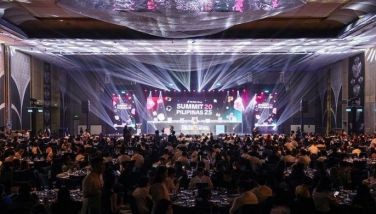Ford puts the focus in Bira
August 17, 2005 | 12:00am
The Bira International Circuit in the resort island of Pattaya, Thailand is a 2.4-kilometer racetrack that features an engaging mix of short straights, medium-speed curves, tricky off-camber corners and multiple elevation changes. The cars that race here span the gamut from Formula 3 single-seaters to a host of two- and four-wheeled vehicles ranging from compact sedans to exotic sports cars and even off-road trucks and SUVs.
But we were there to watch a different kind of race. It’s a race that’s monitored in number of units instead of seconds and where the finishing order is often decided in the boardroom rather than the finish line. In other words, this is a race for compact sedan sales supremacy. And the principal contenders? Honda and Toyota, of course, and Ford with its newest player, the all-new Ford Focus.
As even a casual industry observer might glean, Ford is fighting an uphill battle in the high-profile compact sedan stakes and needs an equally high-profile model to contest it with. And judging from first impressions, the new Ford Focus is well-suited for that role. Styling of course determines much of a car’s success in the marketplace and the Blue Oval company heaped it on the Focus in spades.
The model that will replace the perennially underrated Lynx in the ASEAN region wears not just a body that oozes European appeal, but a platform that also underpins the much more exclusive — and expensive — Volvo S40.
The front end begins the play with the popular "cat’s eye" headlamp treatment. These headlamps flank a bold mesh grille with the Ford Blue Oval logo in the center. The bumper, which actually makes up much of the front, creates a highly aggressive face — thanks to gaping air intakes below the license plate and around the foglight openings.
Viewed from the side, the front and rear fender flares take centerstage. A sharp-edged character line emanates from the top of the fenders and stretches the length of the car while a softer one bisects the door handles. A triangular quarter window on the rearmost pillar — instead of being positioned beside the rear door window itself — reinforces the European feel as this stylistic treatment is seen more often on Audis and Volvos.
The rear end, although completely new, will be the one most familiar to Lynx owners. It has large triangular taillamps that bracket a smooth gimmick-free trunklid with a neat ducktail edge where the vertical and horizontal planes meet.
Viewed as a whole, the new Ford Focus bristles with cutting-edge styling cues that make the car look bigger than it actually is and endow it with that hard-to-achieve look of motion even when the car is standing still.
So confident is Ford of the driving dynamics of the Focus that they brought along the car’s principal rivals — the Toyota Corolla Altis and the Honda Civic — for back-to-back comparisons of everything from engine responsiveness to braking power to riding comfort to directional stability to overall fit-and-finish.
The contests were in ABS-induced panic-braking from 80 kph along the pitlane, slalom runs around orange pylons on the main straight of the Bira racetrack, a few flat-out blasts on the short straights and, to gauge the car’s bump isolation, intentional running over of the low kerbs just like in Formula One.
Needless to say, the Focus came through with flying colors, posting the shortest stopping distance, feeling every bit as nimble as the smaller Civic in the slalom, delivering energetic acceleration on the short straights and exhibiting true Euro-sedan shock absorption when apexing the tracks’ curbs in our best Kimi Raikkonen imitation.
The Focuses we drove had 1.8-liter (125 ps @ 6000 rpm and 165 Nm of torque @ 4000 rpm) and 2.0-liter (145 ps @6000 rpm and 185 Nm @ 4500 rpm) Duratec engines. The 1.8 motor came with the four-door sedan while the 2.0 powerplant was fitted to the sporty five-door hatchback that should be available locally before the end of the year.
These engines are not exactly class-leading in terms of power, lacking variable valve timing, for instance (they do have Variable Intake Systems). What these engines do have in abundance is refinement, an enjoyably fat torque curve, admirably low levels of noise, vibration and harshness and, according to Ford, European-car-like engine longevity with a 240,000-kilometer or ten-year service life.
The supple yet responsive ride and handling is courtesy of the Focus’ aforementioned Volvo platform that uses a stiff new front subframe, a robustly built suspension featuring advanced-geometry McPherson struts with lower control arms in front and a novel new Control Blade independent rear suspension. The steering, which boasts a hybrid electric-hydraulic power-assist system, is ideally weighted to endow it with light effort at parking speeds yet firms up at high speed for good directional stability. Its strong braking power comes from large 300-mm front discs and 280-mm rear discs abetted with ABS.
Open the doors and the Focus welcomes you to a spacious and functional cabin. The all-black dashboard is livened up by silver accents on the steering wheel, shift knob, gearshift lever base and the oval-shaped aircon vent surrounds as well as by the cream-colored leather upholstery and door panels. The Focus was designed to be roomier than the benchmark Corolla Altis and has succeeded in this respect, with the Ford boasting slight but nevertheless noticeably greater head-, shoulder-, and legroom than the Toyota.
The Bira racetrack did not provide for instrumented testing but our seat-of-the-pants feel verified pretty much all the claims made by Ford executives in their speeches at the Learning Resort in Pattaya: and that’s the new Ford Focus is one well-rounded player in the high-stakes compact sedan competitions. Now if this P919,000 Ford sedan will upset the competition, only time — and legions of fickle-minded buyers — will tell. One thing’s for sure — Ford wields the strongest weapon it has ever had to pull it off.
But we were there to watch a different kind of race. It’s a race that’s monitored in number of units instead of seconds and where the finishing order is often decided in the boardroom rather than the finish line. In other words, this is a race for compact sedan sales supremacy. And the principal contenders? Honda and Toyota, of course, and Ford with its newest player, the all-new Ford Focus.
As even a casual industry observer might glean, Ford is fighting an uphill battle in the high-profile compact sedan stakes and needs an equally high-profile model to contest it with. And judging from first impressions, the new Ford Focus is well-suited for that role. Styling of course determines much of a car’s success in the marketplace and the Blue Oval company heaped it on the Focus in spades.
The model that will replace the perennially underrated Lynx in the ASEAN region wears not just a body that oozes European appeal, but a platform that also underpins the much more exclusive — and expensive — Volvo S40.
The front end begins the play with the popular "cat’s eye" headlamp treatment. These headlamps flank a bold mesh grille with the Ford Blue Oval logo in the center. The bumper, which actually makes up much of the front, creates a highly aggressive face — thanks to gaping air intakes below the license plate and around the foglight openings.
Viewed from the side, the front and rear fender flares take centerstage. A sharp-edged character line emanates from the top of the fenders and stretches the length of the car while a softer one bisects the door handles. A triangular quarter window on the rearmost pillar — instead of being positioned beside the rear door window itself — reinforces the European feel as this stylistic treatment is seen more often on Audis and Volvos.
The rear end, although completely new, will be the one most familiar to Lynx owners. It has large triangular taillamps that bracket a smooth gimmick-free trunklid with a neat ducktail edge where the vertical and horizontal planes meet.
Viewed as a whole, the new Ford Focus bristles with cutting-edge styling cues that make the car look bigger than it actually is and endow it with that hard-to-achieve look of motion even when the car is standing still.
So confident is Ford of the driving dynamics of the Focus that they brought along the car’s principal rivals — the Toyota Corolla Altis and the Honda Civic — for back-to-back comparisons of everything from engine responsiveness to braking power to riding comfort to directional stability to overall fit-and-finish.
The contests were in ABS-induced panic-braking from 80 kph along the pitlane, slalom runs around orange pylons on the main straight of the Bira racetrack, a few flat-out blasts on the short straights and, to gauge the car’s bump isolation, intentional running over of the low kerbs just like in Formula One.
Needless to say, the Focus came through with flying colors, posting the shortest stopping distance, feeling every bit as nimble as the smaller Civic in the slalom, delivering energetic acceleration on the short straights and exhibiting true Euro-sedan shock absorption when apexing the tracks’ curbs in our best Kimi Raikkonen imitation.
The Focuses we drove had 1.8-liter (125 ps @ 6000 rpm and 165 Nm of torque @ 4000 rpm) and 2.0-liter (145 ps @6000 rpm and 185 Nm @ 4500 rpm) Duratec engines. The 1.8 motor came with the four-door sedan while the 2.0 powerplant was fitted to the sporty five-door hatchback that should be available locally before the end of the year.
These engines are not exactly class-leading in terms of power, lacking variable valve timing, for instance (they do have Variable Intake Systems). What these engines do have in abundance is refinement, an enjoyably fat torque curve, admirably low levels of noise, vibration and harshness and, according to Ford, European-car-like engine longevity with a 240,000-kilometer or ten-year service life.
The supple yet responsive ride and handling is courtesy of the Focus’ aforementioned Volvo platform that uses a stiff new front subframe, a robustly built suspension featuring advanced-geometry McPherson struts with lower control arms in front and a novel new Control Blade independent rear suspension. The steering, which boasts a hybrid electric-hydraulic power-assist system, is ideally weighted to endow it with light effort at parking speeds yet firms up at high speed for good directional stability. Its strong braking power comes from large 300-mm front discs and 280-mm rear discs abetted with ABS.
Open the doors and the Focus welcomes you to a spacious and functional cabin. The all-black dashboard is livened up by silver accents on the steering wheel, shift knob, gearshift lever base and the oval-shaped aircon vent surrounds as well as by the cream-colored leather upholstery and door panels. The Focus was designed to be roomier than the benchmark Corolla Altis and has succeeded in this respect, with the Ford boasting slight but nevertheless noticeably greater head-, shoulder-, and legroom than the Toyota.
The Bira racetrack did not provide for instrumented testing but our seat-of-the-pants feel verified pretty much all the claims made by Ford executives in their speeches at the Learning Resort in Pattaya: and that’s the new Ford Focus is one well-rounded player in the high-stakes compact sedan competitions. Now if this P919,000 Ford sedan will upset the competition, only time — and legions of fickle-minded buyers — will tell. One thing’s for sure — Ford wields the strongest weapon it has ever had to pull it off.
BrandSpace Articles
<
>
- Latest
Latest
Latest
April 8, 2025 - 5:00pm
April 8, 2025 - 5:00pm
March 11, 2025 - 11:00am
March 11, 2025 - 11:00am
February 10, 2025 - 2:30pm
February 10, 2025 - 2:30pm
February 6, 2025 - 4:36pm
February 6, 2025 - 4:36pm
Recommended



























